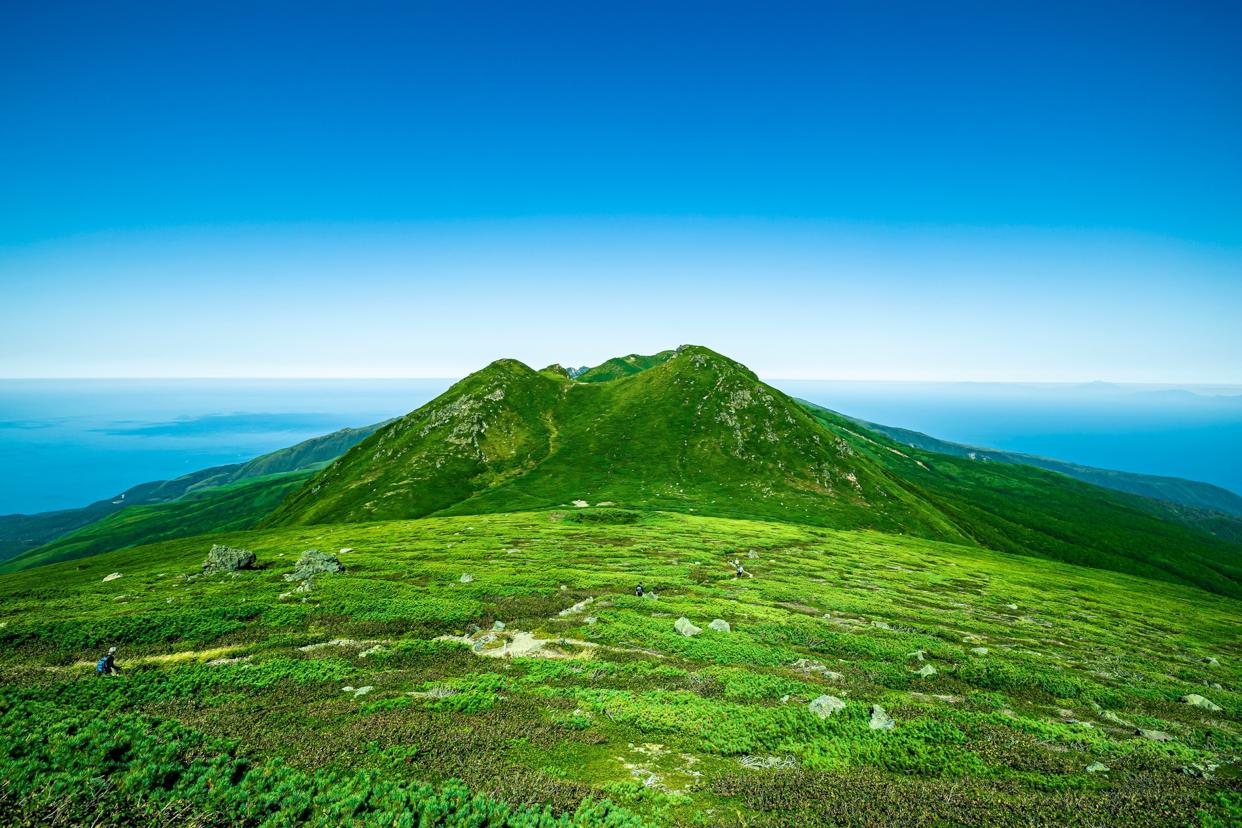
With its sacred mountains, volcanic hot springs and white sand beaches, northern Japan abounds with natural wonders. These spectacular landscapes, and their rich tapestry of flora and fauna, are reflected best within the region’s two UNESCO World Heritage Sites: Shirakami-Sanchi, in northwest Tohoku, and Shiretoko, on the northeastern tip of Hokkaido.
Shirakami-Sanchi, north of Tokyo on Japan’s main island of Honshu, stands as a stark contrast from the capital. Here, serene rice paddies and quaint villages rise into the tree-covered mountain ranges of the Tohoku region, and hikers share old-growth forests with Japanese serow (a goat-like mammal), Japanese black bears and snow monkeys. Meanwhile, across the Tsugaru Strait, Hokkaido’s eastern reaches unfold into one of the nation’s greatest wildernesses, the remote Shiretoko Peninsula. This landscape, characterised by mirror-like lakes and towering mountains, is home to a variety of wildlife, including brown bears and Ezo red foxes, while its icy coastal waters are often split by the dramatic spray of orcas. Here’s how to explore these remote destinations.

Shirakami-Sanchi
When UNESCO first included Japan on its World Heritage List (in 1992), Shirakami-Sanchi was one of the four sites selected. Yet this mountainous region in northwest Tohoku remains largely off the radar of international visitors. Those who do make the journey will discover a timeless enclave, blanketed in the last remnants of the endemic Siebold’s beech (Japanese beech) forest that covered the prefecture 8,000 years ago. The area is a precious haven of prehistoric ecology — botanists can marvel at the ancient trees and rare plants such Sasa kurilensis, an evergreen bamboo, and birders can seek out golden eagles and black woodpeckers. The forests are also home to a variety of native animals, such as the Japanese serow and the magnificent Japanese black bear.




Such pristine nature and wildlife make Shirakami-Sanchi a haven for hikers, and a number of scenic trails crisscross its rugged expanse. The most popular of these leads to the three-tiered Anmon Falls, which are found in the protected UNESCO World Heritage zone. To visit this area, travellers need to submit a hiking plan at the park’s visitor centre. Other attractions include the otherworldly Nihon Canyon, the unexpectedly pretty Tanashiro Swamp and the beautiful Juniko trail, a moderate, half-day hike taking in 12 lakes. Shirakami-Sanchi’s sharp peaks are popular too, especially Shirakami-dake — the highest peak in the park at 4,050ft, and one of few that can be accessed by public transport.
While cars are needed to reach some trailheads, Shirakami-Sanchi’s wilderness is largely devoid of roads, making hiking a happy necessity. The best time to visit is from April to November, as many trails are seasonal and winter snowfall can make various routes increasingly difficult. Accommodation options generally circle Shirakami-Sanchi’s perimeter — opt for a seaside onsen hotel, a city stay in charming Hirosaki or find tranquillity at Hotel Yutoria Fujisato.

Shiretoko
A far-flung peninsula on the northeastern tip of Hokkaido, Shiretoko National Park is one of Japan’s most pristine natural regions. Its name, which derives from the Indigenous Ainu word ‘sir etok’, meaning ‘the place where the earth protrudes’, is justified by its snowy peaks and 300-ft cliffs that descend into the Sea of Okhotsk, all framed by shifting drift ice. But the area is far more than just its rugged, natural beauty. Shiretoko earned UNESCO World Heritage status in 2005 for its interconnected marine and terrestrial ecosystems. It’s home to Japan’s densest brown bear population, for example, as well as Ezo red foxes, Ezo Shika deer and more than 260 bird species. Its waters are equally abundant, teeming with spotted seals, Steller’s sea lions and whales. Travellers should book a sightseeing cruise to scan the horizon for breaching orcas and sperm whales, and to spot brown bears hunting for salmon along the pebbled shores.




Hiking is another great way to experience all Shiretoko has to offer — easy trails incorporate highlights like Furepe Falls, Rausu’s geysers and wetlands, and the idyllic Goko (Five Lakes). Those looking for a challenge, meanwhile, can opt to scale the precipitous Mount Rausu-dake — Shiretoko’s highest summit, at 5,450ft. Come winter, there’s the option to snowshoe or hike along the drift ice. Shiretoko National Park is also the site of inviting hot springs, such as Kamuiwakka Hot Falls waterfall, accessible via a shuttle bus transfer or a guided hike that’s enjoyable year-round.
Roads fade away three-quarters of the way along the Shiretoko Peninsula, so boat tours or multi-day treks are the most convenient ways for visitors to reach its northernmost point. The port town of Utoro is a handy spot for a base, offering a variety of accommodation options from luxury hotels to well-equipped campsites. The town of Rausu, on the eastern coast, also has a range of hotels, guest houses and lodges.
This is paid content for World Natural Heritage in Japan. It does not necessarily reflect the views of National Geographic, National Geographic Traveller (UK) or their editorial staffs.
To subscribe to National Geographic Traveller (UK) magazine click here.
(Available in select countries only).







